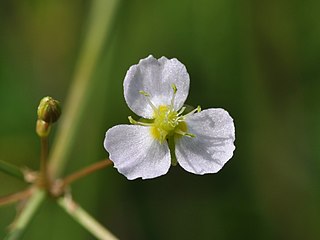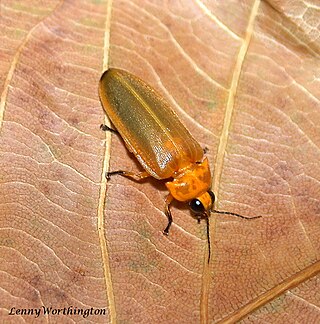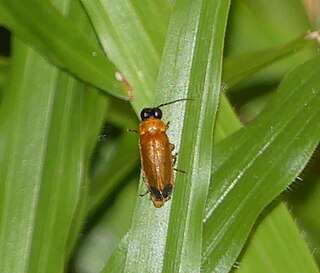
The Lampyridae are a family of elateroid beetles with more than 2,000 described species, many of which are light-emitting. They are soft-bodied beetles commonly called fireflies, lightning bugs, or glowworms for their conspicuous production of light, mainly during twilight, to attract mates. Light production in the Lampyridae is thought to have originated as an honest warning signal that the larvae were distasteful; this was co-opted as a mating signal in the adults. In a further development, female fireflies of the genus Photuris mimic the flash pattern of Photinus species to trap their males as prey.

Alisma plantago-aquatica, also known as European water-plantain, common water-plantain or mad-dog weed, is a perennial flowering aquatic plant widespread across most of Europe and Asia, and apparently spread elsewhere in both the Old and New World.

Ipomoea aquatica, widely known as water spinach, is a semi-aquatic, tropical plant grown as a vegetable for its tender shoots. I. aquatica is generally believed to have been first domesticated in Southeast Asia. It is widely cultivated in Southeast Asia, East Asia, and South Asia. It grows abundantly near waterways and requires little to no care.

Luciola is a genus of flashing fireflies in the family Lampyridae. They are especially well known from Japan and are often called Japanese fireflies, but their members range farther into Asia and reach southern Europe and Africa. This genus is traditionally held to extend to Australia, but these species do not seem to belong herein.

The Luciolinae are among the largest subfamilies of fireflies (Lampyridae). They seem to be all "flashing" fireflies. They are a diverse lineage, spreading throughout the warm parts of Eurasia into temperate Europe and East Asia and south to the Australian region.
Atyphella is a genus of 'flashing' firefly found in the Australasian region, particularly in the eastern and northern regions of Australia. The genus consists of 23 recognized species, 14 considered to be endemic to Australia.
Inflata is a genus of 'flashing' firefly found in Thailand, containing a single recognized species, Inflata indica.
Atyphella dalmatia is a species of firefly in the genus Atyphella. It was discovered in 2009.

Nipponoluciola cruciata, known as "genji-botaru" (ゲンジボタル) in Japanese, is a species of firefly found in Japan. Its habitat is small ditches and streams, and its larvae are aquatic. It was formerly known as Luciola cruciata but was revised taxonomically in 2022.
Listeria aquatica is a Gram-positive, facultatively anaerobic, nonmotile, non-spore-forming rod-shaped species of bacteria. It is not pathogenic. It was discovered from running water in Florida, and was first described in 2014. Its name comes from Latin, "found in water, aquatic".
Aquatica ficta is a species of firefly found in Taiwan and parts of China. It was formerly placed in the genus Luciola. Its habitat is still water, and the larvae are aquatic.
Aquatica hydrophila is a species of firefly found in Taiwan. Described in 2003, it was formerly placed in the genus Luciola. The larvae are aquatic and live in ditches and small streams.

Aquatica lateralis, known as "heike-botaru" (ヘイケボタル) in Japanese, is a species of firefly found in Russia, Japan and Korea. It was formerly placed in the genus Luciola. The larvae are aquatic and live in rice paddies.
Abscondita chinensis, is a species of firefly beetle found in India, China and Sri Lanka.
Abscondita promelaena is a species of firefly beetle found in India and Sri Lanka.
Luciola candezei, is a species of firefly beetle found in Sri Lanka.
Luciola intricata, is a species of firefly beetle found in Sri Lanka.

Pteroptyx is a genus of fireflies in the subfamily Luciolinae found in Southeast Asia. It has long been noted for the ability to perform synchronous flashing, though not all species synchronize. These synchronizing species have been found on so-called 'firefly trees' and created a growing firefly-watching tour industry in some regions. Species of the genus have been identified in Malaysia, Thailand, the Philippines, and Hong Kong.

Abscondita is a genus of fireflies in tropical Asia. Species in the genus were earlier placed in the genus Luciola but molecular phylogeny studies support their separation.

Asymmetricata is a genus of fireflies found in tropical Asia. Species in the genus were formerly included in the genus Luciola. The genus was created in 2009 by Lesley Ballantyne who noted the asymmetric 8th abdominal tergite, emarginated on its left, as a shared feature. Adults of both males and females are winged. The larvae have been reliably described only in A. circumdata. They are terrestrial carnivores, feeding on snails and earthworms in moist soil below tree cover. The last abdominal segment bears an anchoring structure or pygopod with 58 or more pygopodia arising from it.








